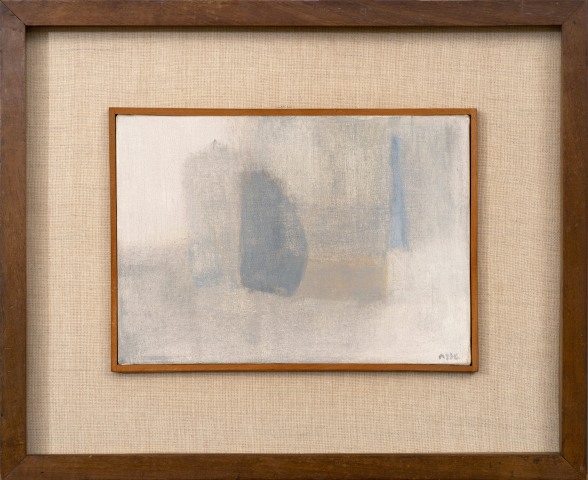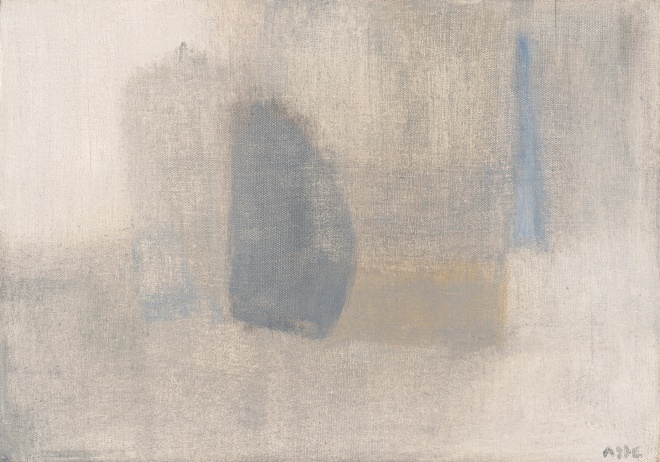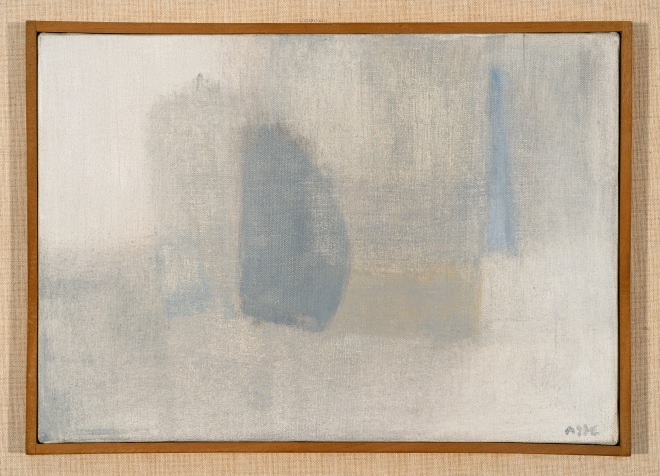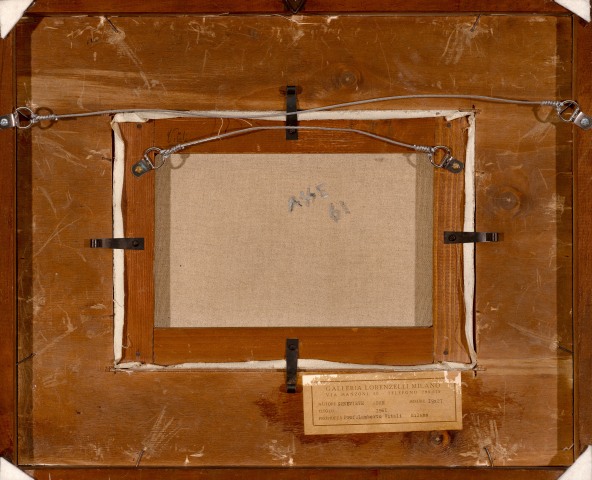Geneviève Asse
Untitled, 1961
Oil on canvas
19.5 x 27cm, in its original frame
4P C
€ 34,000 + ARR
Further images
Geneviève Asse’s “Untitled” from 1961 is a striking example of the artist's nuanced exploration of colour and form. Executed in oil on canvas, this work is characterised by its minimalist...
Geneviève Asse’s “Untitled” from 1961 is a striking example of the artist's nuanced exploration of colour and form. Executed in oil on canvas, this work is characterised by its minimalist composition and a subtle interplay of soft grays, beige, and a delicate touch of blue. The restrained palette creates a serene, contemplative atmosphere, inviting the viewer to immerse themselves in the painting's quiet depth.
The current painting was first exhibited at Galleria Lorenzelli in Milan in 1961, and marks an important moment in her career. The painting has remained in the same collection since its exhibition and is in perfect condition, maintaining its original frame, a testament to its enduring appeal and the care it has received.
Geneviève Asse and Giorgio Morandi: A Quiet Influence
It was in 1961 that Geneviève Asse and Giorgio Morandi met and marked a pivotal moment in her career, yet his influence on her work began long before their meeting. Asse had long admired Morandi’s contemplative still lifes, marked by their simplicity, subtle tonal shifts, and focus on space and light. Even in the 1950s, her work reflected these qualities, as she gravitated towards a more restrained aesthetic with a reduced palette of whites and blues.
Morandi’s quiet, meditative approach to painting resonated with Asse’s own developing focus on minimalism and abstraction. His ability to evoke depth and emotion through simple forms and tonal variations influenced her growing interest in creating vast, open spaces within her compositions. After meeting him, this influence became even more pronounced, leading Asse further into abstraction, where light and materiality became central to her work, echoing Morandi’s disciplined simplicity and sense of contemplation.
Geneviève Asse (1923-2021) was a French painter and printmaker renowned for her refined approach to abstraction. Born in Vannes, Brittany, Asse's early exposure to the natural beauty of the French coastline profoundly influenced her artistic vision. She studied at the École nationale supérieure des arts décoratifs in Paris, where her work evolved from figurative traditions to embrace abstraction.
Asse is associated with the Lyrical Abstraction movement, a subset of the broader School of Paris. This movement emphasises the emotional and expressive potential of abstract art through subtle colour gradations and restrained forms. Influenced by modernist masters such as Paul Cézanne, Piet Mondrian, and Nicolas de Staël, Asse developed a unique style marked by its meditative quality and exploration of light and space.
The present work embodies Asse’s approach to painting as a meditative practice, where the simplicity of form opens up profound possibilities for introspection. Her work is often noted for its ability to evoke calm and contemplation through minimalism and a carefully curated colour palette. Asse’s dedication to her craft and her capacity to convey emotional depth through subtle abstraction set her apart in the 20th-century art world.
As a pioneering female artist in a predominantly male-dominated field, Asse’s achievements are particularly significant. Her work not only reflects a personal vision but also contributes to the broader narrative of women in art.
The current painting was first exhibited at Galleria Lorenzelli in Milan in 1961, and marks an important moment in her career. The painting has remained in the same collection since its exhibition and is in perfect condition, maintaining its original frame, a testament to its enduring appeal and the care it has received.
Geneviève Asse and Giorgio Morandi: A Quiet Influence
It was in 1961 that Geneviève Asse and Giorgio Morandi met and marked a pivotal moment in her career, yet his influence on her work began long before their meeting. Asse had long admired Morandi’s contemplative still lifes, marked by their simplicity, subtle tonal shifts, and focus on space and light. Even in the 1950s, her work reflected these qualities, as she gravitated towards a more restrained aesthetic with a reduced palette of whites and blues.
Morandi’s quiet, meditative approach to painting resonated with Asse’s own developing focus on minimalism and abstraction. His ability to evoke depth and emotion through simple forms and tonal variations influenced her growing interest in creating vast, open spaces within her compositions. After meeting him, this influence became even more pronounced, leading Asse further into abstraction, where light and materiality became central to her work, echoing Morandi’s disciplined simplicity and sense of contemplation.
Geneviève Asse (1923-2021) was a French painter and printmaker renowned for her refined approach to abstraction. Born in Vannes, Brittany, Asse's early exposure to the natural beauty of the French coastline profoundly influenced her artistic vision. She studied at the École nationale supérieure des arts décoratifs in Paris, where her work evolved from figurative traditions to embrace abstraction.
Asse is associated with the Lyrical Abstraction movement, a subset of the broader School of Paris. This movement emphasises the emotional and expressive potential of abstract art through subtle colour gradations and restrained forms. Influenced by modernist masters such as Paul Cézanne, Piet Mondrian, and Nicolas de Staël, Asse developed a unique style marked by its meditative quality and exploration of light and space.
The present work embodies Asse’s approach to painting as a meditative practice, where the simplicity of form opens up profound possibilities for introspection. Her work is often noted for its ability to evoke calm and contemplation through minimalism and a carefully curated colour palette. Asse’s dedication to her craft and her capacity to convey emotional depth through subtle abstraction set her apart in the 20th-century art world.
As a pioneering female artist in a predominantly male-dominated field, Asse’s achievements are particularly significant. Her work not only reflects a personal vision but also contributes to the broader narrative of women in art.
Provenance
with Galleria Lorenzelli, Milan, 1961, no. 13Professor Lamberto Vitali, Milan, acquired above and by descent until 2024







